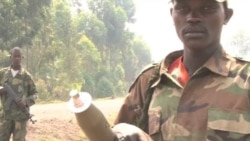M23 Rebels
M23 rebel group:- Formed in early 2012
- Named for March 23, the date of a 2009 peace deal
- Also known as the Congolese Revolutionary Army
- Includes fighters once loyal to a rebel army who assimilated into the DRC army, then defected
- Dominated by the Tutsi ethnic group
- Its leader Bertrand Bisimwa said Nov. 5, 2013, that the group is laying down its arms
- UN experts say the group is backed by Rwanda, which Rwanda denies
In a statement Tuesday, M23 President Bertrand Bisimwa requested rebel commanders prepare fighters for “disarmament, demobilization and social reintegration.”
Bisimwa said the group would pursue its goals through political means.
M23 seized parts of Congo's North Kivu province last year. But the Congolese military, backed by United Nations forces, has steadily retaken territory from M23 in recent weeks.
Congolese government spokesman Lambert Mende said military operations effectively ended overnight with the capture of the last two rebel positions in Tshanzu and Runyoni near the borders of Uganda and Rwanda.
“Militarily we can say that M23 was disbanded. They are now escaping here and there but they have no control over a single village,” Mende said.
African leaders meeting in South Africa Monday called for the rebels to lay down their arms to make way for a peace accord with the government.
Peace talks between M23 leaders and the Congolese government held in the Ugandan capital Kampala broke down last month.
Mende said he hopes the rebel leaders will engage in the peace process.
“We need them around the table so that we consolidate this new situation by political discussions. We must end what we started in Kampala,” he said.
The M23 rebellion was launched in April 2012 by disaffected soldiers angry with the government for failing to honor the terms of a previous peace agreement.
Rights groups, the United Nations and some foreign governments have accused Rwanda of supporting the rebellion, a claim Kigali has repeatedly denied.










